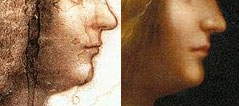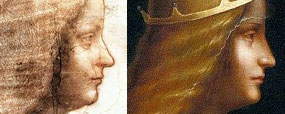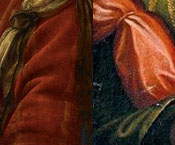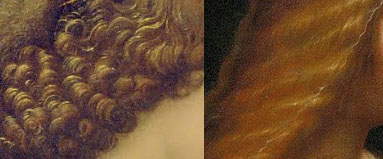Why the portrait of Isabella d'Este is not by Leonardo da Vinci
Here we go again: another great masterpiece popped up out of the blue, again by a great artist (this time Leonardo da Vinci), has jumped into the headlines after Sette magazine published a few days ago, on October 4 to be exact, an article in which it practically took for granted the discovery of a portrait of Isabella d’Este that Leonardo allegedly painted and that is allegedly kept in a Swiss collection. But it was enough to observe the photograph of the portrait to immediately nurture several doubts later confirmed by many who wrote articles rejecting Leonardo’s attribution (from Tomaso Montanari even going as far as Vittorio Sgarbi, who contrary to what he did for the infamous one hundred Caravaggio drawings, this time sides against the “scoop”).
We, too, are obviously against this hasty attribution, not least because those few reasons given seem completely flimsy. For example, the “evidence” of carbon 14 examination, which would grant the work “95.4 percent probability” of having been executed between 1460 and 1650: a time span of almost two hundred years that is perfectly useless for serious analysis. Or the theory that “the imprimitura of the canvas is prepared according to the recipe written by Leonardo in his Treatise” (nothing prohibits that others could have followed the same method). However, many of those who speak out against the attribution, being art historians and not popularizers, perhaps take for granted things that instead for the general public may not be taken for granted (given many comments we have read to articles that have appeared in the online versions of major newspapers), so with this article we try to explain why the portrait of this Isabella d’Este disguised as Catherine of Alexandria (the crown and the palm of martyrdom are in fact later additions, and on this everyone agrees) cannot be by Leonardo. It is worth pointing out, however, that the first analysis one makes when trying to attribute a work of art is stylistic, that is, one tries to compare a painting with the typical features of the artist to whom one wants to attribute it in order to find similarities or differences. However, let us see for what reasons the work cannot be considered a Leonardo autograph:
- chiaroscuro passages. Leonardo was famous for his sfumato technique, based on very fine chiaroscuro passages that made the depicted subject almost merge with the surrounding atmosphere. In the “rediscovered” painting these fine chiaroscuro passages are not there, because they are sharp and almost violent. See for example the image below, where we have on the left the hands of the Mona Lisa and on the right the hand of the alleged portrait of Isabella d’Este:

The image of the alleged portrait is low resolution, although nevertheless it is the best we have found (and often the colors of a work turn out to be altered in digital images): in any case, in all the images we can find of Isabella d’Este, the detail of the hands is always marked by this strong transition that has nothing of Leonardo’s about it. Note, moreover, the index finger, which is excessively elongated and almost deformed to be considered the work of Leonardo (who let us remember was one of the artists most attentive to the study of anatomy). We can make the same considerations about chiaroscuro by looking at the face:

On the left we have the drawing of Isabella d’Este (this one, yes, by Leonardo) kept in the Louvre: we notice here, too, a finer and more delicate chiaroscuro transition, which also reveals to us the shape of the chin, which is not the case in the Swiss portrait (shown here, we recall, in the best image we found on the web). - Gaze. Leonardo was capable of making very deep looks with great psychological intensity. This is apparent to us if we also look at the Louvre drawing, where the eyes of the Marquise of Mantua convey the pride and pride typical of a strong woman who ruled firmly over an Italian Renaissance state. The same cannot be said of Isabella-Caterina, who does not communicate these feelings; in fact, she seems almost sleepy:

- Panneggi. Leonardo accustomed us to very delicate, soft draperies, in keeping with his painting technique endowed with great refinement. We have here compared a piece of the draperies of the Belle Ferronnière, one of Leonardo’s finest portraits (perhaps the finest), with those of the Isabella-Caterina:

It does not require an experienced eye to notice how delicate and verisimilitude the Belle Ferronnière’s draperies are and how angular and almost unnatural those of the Swiss portrait are.
- Hair. Isabella-Caterina’s hair also seems to lack volume. We have compared them here with the hair of the angel in the Annunciation preserved in the Uffizi, an early masterpiece by our artist:

Here, too, we notice in the real Leonardo an elaborate hairdo, with the light resting on the angel’s curls in a verisimilar manner, just as verisimilar are, consequently, the areas of shadow, and all this gives thickness and three-dimensionality to the hair, something that cannot be said of the hair of the rediscovered Isabella d’Este.
These are some of the main stylistic reasons that lead us to seriously doubt Leonardo’s attribution. Then it goes without saying that no one forbids us to think that Leonardo may perhaps have been the real author of the portrait, probably under the influence of alcohol or drugs (given the final result of the painting), which would not in any case clash with the image of the genius of Vinci offered by recent television elaborations such as Da Vinci’s Demons. It would, however, take great imagination for an attribution of this kind, imagination that is indeed a great quality, but its abuse, especially in the history of art, leads to very uncomfortable results and above all can lead the discipline to lose credibility.
Warning: the translation into English of the original Italian article was created using automatic tools. We undertake to review all articles, but we do not guarantee the total absence of inaccuracies in the translation due to the program. You can find the original by clicking on the ITA button. If you find any mistake,please contact us.



























